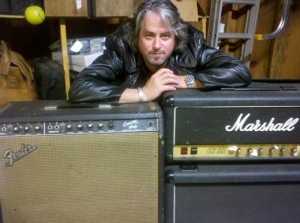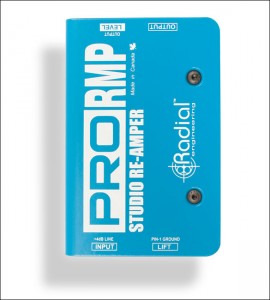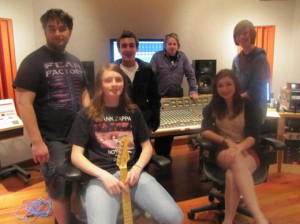All Mixed Up? Reamping Techniques — by Jamey Staub
The first in a series on raising your mix game, from the accomplished NYC mixer/producer Jamey Staub. Visit him early/often at http://www.jameystaub.com.
As most of you know, the job of a music producer requires one to be versatile: Projects range from A-list celebrities to unknown bands that need development.
I’ve worked with everyone from Everlast to Korn to Mary J. Blige (that’s the A-list), but a recent project of mine falls in with that “unknown” category — I recently produced a young rock band by the name of IspaceWalkSometimes.
I love these guys not only because they write great music, but are amazing musicians for their age. They are also former students of mine.
We had a very limited budget so we had to find a reasonable studio and record as quickly as possible. We chose OK Records Studio in Nyack, New York and recorded eight songs in fifteen hours.
Reamping to the Rescue!
A problem that arose during the mix phase was the guitar tones that were recorded due to our limited time restraint in the studio — we just did not have enough time to dial in the perfect sound.
This is not uncommon and can be fixed by several methods. One is the process of “reamping,” and there are several ways to go when this issue arises.
One way is to utilize a reamping device. A re-amping device commonly employs a reversed Direct Inject (DI) transformer with some resistors added for level and impedance shift. Level and impedance adjustment can be achieved by adding a potentiometer or adjustable resistor.
A proper re-amping device converts a balanced signal to an unbalanced signal, reduces a high studio-level (line-level) signal down to a low guitar-level signal, and shifts the output to a high instrument-level impedance (typically a guitar pickup impedance).
In this case you can take a recorded signal, run it back through the guitar amp of your choice and take the time to adjust the settings to your liking as called for by the song style. We often used this method in the late ‘80’s and ’90’s.
Reamp it in the Box – the Right Way
These days, however, there are other options. What I did on the song “What’s Left to See,” by IspaceWalkSometimes was much simpler. I used a plug-in! The song is an Iron Maiden-inspired tune with multiple lead guitar melodies. One of the guitar tracks was too clean for the harmony track, so I put a guitar amp plug-in Amplitube on the insert and voila, after a bit of tweaking got the sound I wanted for the track.
There are several other choices such as Amp Farm which I love because of the many different amp choices available, plus the graphics are cool. Logic Pro also has a decent amp simulation plug-in. And of course you can choose the type and placement of the virtual microphone which, is fun and interesting.
One thing to watch out for with plugins, however, is reamping an already distorted signal. By reamping distortion you can end up with a sound fraught with too many harmonics resulting in white noise and no tone. If the signal is too hot to put an amp simulator plugin on the insert, create an auxillary track and insert the amp simulator there. Then buss the pre-recorded signal to the aux track and adjust the input level via fader level of the original track. This allows you to control the amount of distortion or other effects in the plug-in world just as the reamping device does in the physical world.
You can then buss the aux track to a new audio track and record the result to make your mix complete.
Into an Amp and Back
Plug-ins are easy and useful, but what if your simulator doesn’t have the amp that you’re really looking for?
Don’t settle for mediocrity! I have a Fender Concert Amp with four Celestion speakers that I just love. When I want to use that beauty, I use a reamping device. Simply send your guitar signal out of a free output of your converter (If you are using your laptop’s converter and only have a stereo output you will have to solo the guitar track so that the entire mix doesn’t get sent to the amp; or pan the mix to one side and the guitar to the other – that way you can monitor the mix while tweaking the amp settings) into the reamping device and into the input of the real amp.
This way, not only are you actually moving air with the speaker, you are also allowing yourself to use several different mics to capture the physical space you are in (i.e. a church, gymnasium or bathroom.)
One method I use to record guitar amps is to use a dynamic mic (Shure SM57 or Senheiser 421) close to the speaker (3-6 inches) and a condenser room mic (Neuman U 87 or AKG 414) (6-15 feet). Make sure that the mics are in phase with each other by switching the phase button on your mic pre. If you can’t get them in phase then move the room mic a small amount backward or forward and check the phase again.
Send the live amp sound back into the DAW that you are using and adjust the blend to suit your mix. In my opinion, nothing beats capturing sound in air…
The Moral of the Story
In the world of music production you always have to use the tools available, whether old school or new skool. Just do what you have to do to make it sound RIGHT.
Jamey Staub is a mixer/producer who has learned that if one way doesn’t get you the sound that you are looking for, then try another. To survive in the music world today you have to be willing to experiment. Just remember to have fun while you’re at it!
Please note: When you buy products through links on this page, we may earn an affiliate commission.










SupaMan
May 22, 2012 at 10:04 pm (13 years ago)Very nice. Solid article.
ShadowⓋ
January 31, 2016 at 5:19 am (9 years ago)Bullshit. He failed to mention how many signals are ‘dry’ with little or no distortion on them. This can be very confusing for the novice and might make someone think reamping is done by just using a single track with plugins only, which isn’t usually the case. There’s usually a lot of layering going on using a combination of both normally recorded and dry DI tracks. The article reiterates the same thing like three times and doesn’t clearly explain a thing. It’s more like a vague outline of convoluted knowledge. Very confusing and definitely not concise.